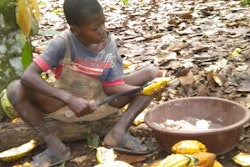
Last October Hershey, Pennsylvania-based Hershey Company revealed their plans to a global commitment of having 100 percent certified cocoa beans by 2020.
Additionally, at the start of 2013 all of Hershey’s Bliss Chocolates are to be made with cocoa beans sourced from Rainforest Alliance Certified farms. Farms that are certified through the Rainforest Alliance are ecological farms that support safe farming conditions for farmers and their families.
According to Andy McCormick, VP of cocoa sustainability for Hershey, 5 percent of the world market currently uses certified cocoa ingredients. This sustainability plan will help the expansion of certified cocoa gain momentum throughout the chocolate industry.
Driving Factors
Emerging market trends around the world is one of the main driving factors for this cocoa initiative. Hershey is expanding business in places like China, India and Brazil.
“I think this is a very unique moment in history where we have these emerging middle classes around the world and the potential to make chocolate available to vast populations that chocolate hasn’t been available to before,” says Frank Day, VP of global commodities for Hershey. “We can deliver chocolate to many people around the world that haven’t had it before and create the demand for the cocoa farmers in West Africa and Indonesia and South America and the only way those cocoa farmers are going to be able to meet that demand is they’ve got to become better.”
“They’ve got to become productive, professional, cocoa farmers,” says Day, “and along the way have a much better livelihood for themselves and their families.”
Consumer interest in where and how cocoa products are sourced is an ongoing trend that influences the movement towards certified cocoa.
Additionally, another driving factor behind this sustainability initiative is to help increase the output and productivity of cocoa farmers, particularly focusing in on West Africa.
Increasing Farmer Productivity
Hershey has been procuring cocoa beans from West Africa for over 50 years; additionally, two thirds of their cocoa originates from West Africa. Roughly 70 percent of the world’s cocoa currently comes from West and Central Africa.
Hershey has invested in various sustainability programs to increase West African farmer productivity with the intention of improving farmers’ economic health and quality of life. The World Cocoa Foundation (WCF), which has about 115 members from the cocoa sector, works to further cocoa sustainability.
“We know it’s very feasible to increase farmer productivity by 50 percent,” says McCormick. “By doing that the farmers will have greater income and cocoa farming will be a more attractive business.”
To help boost farmer output by 50 percent, McCormick suggests the following methods:
- 1) Farmers should have access to fertilizers and pesticides;
- 2) Farmers should be educated on how to apply fertilizers and pesticides safely and productively;
- 3) Farmers should modernize their techniques and harvesting methodologies; and
- 4) Farmers should have access to modern information on farming practices.
In order to give farmers access to modern information, Hershey developed a program in 2011 called CocoaLink, which sends messages that promote sustainable farming practices through SMS messages and voice messaging in local languages.
“Today [January 30, 2013], we’ve sent about 250,000 SMS messages in Ghana,” says McCormick. “We have about 15,000 registered farmers and about 60,000 people benefiting from the program. In 2013 we will be expanding that program into the Ivory Coast.”
Expanding CocoaLink In The Ivory Coast
With approximately 800,000 cocoa farmers across the Ivory Coast, there are many famers and families that could benefit from CocoaLink. Hershey will be partnering with the Ivory Coast Government through their Coffee and Cocoa Committee (CCC) along with their agricultural extension agents.
Mobile technology usage in West Africa has greatly increased in the last two or three years, which is a great tool for farmers to access proper farming practices.
Hershey projects over the next two years – through the outreach from the government and from the private sector – that they will enroll 100,000 Ivory Coast farmers into that program.
“Developing a sustainable supply of cocoa for the world is a challenge for the entire chocolate industry,” notes Day. “We welcome any other chocolate companies around the world to partner with us; they’re free to participate in CocoaLink. It’s certainly our sincere hope that others follow us on that path.”
CocoaLink, along with many other programs, also connects farmers with vital information about child labor and safety.
Eliminating Child Labor
In addition to CocoaLink, Hershey and various chocolate companies are involved with the foundation called the International Cocoa Initiative (ICI). According to ICI’s website:
ICI has identified the main underlying causes of child and forced labor as a result of combination of poverty, ignorance, and lack of social protection policies and system, as well as schooling facilities and in some cases outright exploitation.
ICI helps to train the local farmers on the national rules and regulations of child labor. Furthermore, ICI assists in monitoring cocoa farms and ensures there is progress being made on eliminating child labor. By the end of this year, ICI will have community-based programming in about 550 West African communities, McCormick mentions.
ICI works both at the government level and community level to ensure a protective environment for children in cocoa-growing communities.
“These problems are difficult,” says McCormick. “We are championing an across-the-industry approach because no company, however well-intentioned, can do this alone. We also understand that at the end of the day it must be done in cooperation with the cocoa farmers, the cocoa agents and the governments in West Africa.”
How Chocolate Companies Can Follow Suit
There are many sustainable organizations that can allow companies to commit to sourcing 100 percent certified cocoa. Here is a list of organizations that were mentioned above, in addition to other organizations that help protect the environment and the lives of exploited children and employees:





















